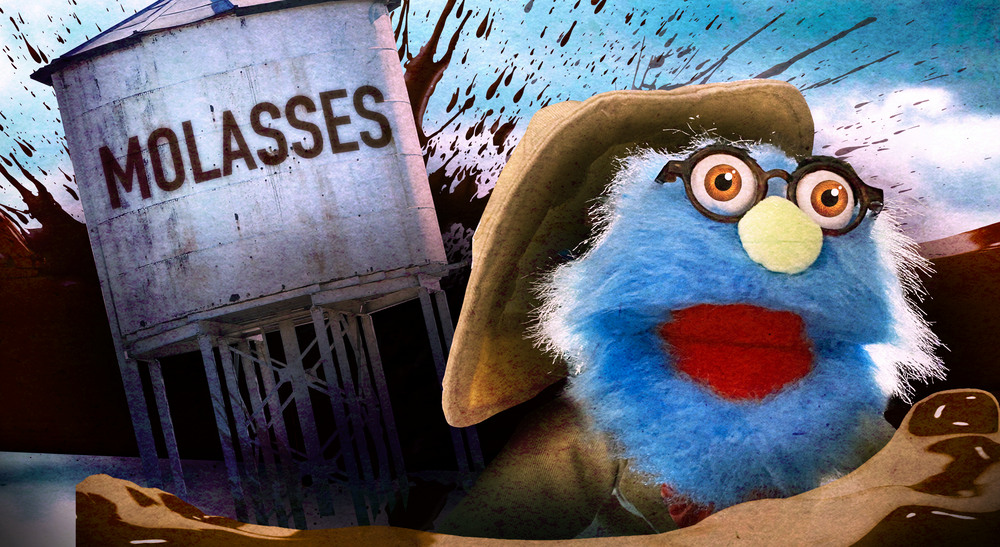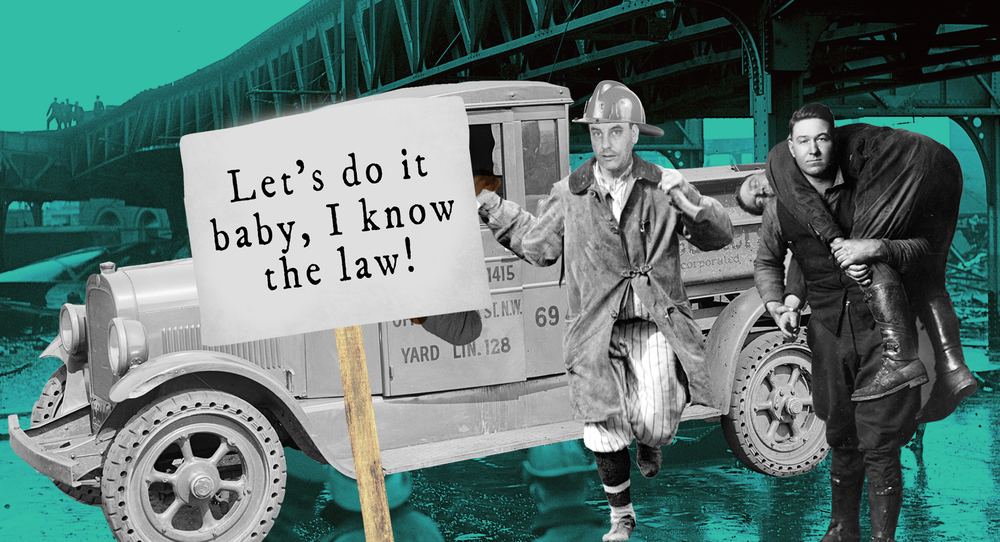
lesson 14 - THE GREAT MOLASSES FLOOD!
Hello and happy week 6 of Puppet History: Online University! It’s me, Liz, back with our final newsletter of the semester. This whole experience has been so positive for me, from working with Kari and The Professor to reading amazing comments from my fellow classmates.
And now I’m here to repay all of that positivity with an absolute bummer of a newsletter! Yes, I’m here to give you *more* of the death, destruction, and of course the major lawsuit that all happened as a result of the Great Molasses Flood of 1919.
Picture a surprisingly nice day in Boston in January. Just two days before the molasses tank erupted, temps had been, like, 2 degrees. As in T-W-O, two! And on the day of the disaster, January 15, it was suddenly 40 degrees Fahrenheit. Not exactly tank top weather, but pretty nice for that time of year. Adults were out running errands, kids were playing outdoors, and workers were enjoying their lunch breaks.
When the tank burst around 12:30 p.m., Boston police officer Frank McManus had just walked in the opposite direction of the tank, narrowly escaping what could have been a terrible death. He told The Boston Post that he felt something hit his back and turned to see the wave bearing down on him. According to McManus, he out-ran the molasses, then was able to get to a phone to call for help before wading back into the mess to help.
As the molasses glooped its way down streets, it scooped everything up and brought it along – furniture, garbage, animals, cars, and of course, people. It even moved entire buildings.
The Clougherty house, which had been situated right next to the tank, was hit by the wave and smashed into a large beam holding up the elevated train tracks. One neighbor was quoted as saying she witnessed the house “fly into the air”. The owner of the home, 65-year-old Bridget Cloughtery, was severely injured and died shortly after a rescue crew pulled her out. Her son, Martin, was also at home and survived the incident. He had worked the night shift and was asleep in bed when the molasses hit their house. He told the press at the time, “The first impression I had that something unusual had happened was when I awoke in several feet of molasses. It didn’t dawn on me that it was molasses I was in. I thought I was overboard.”
As The Professor mentioned, the nearby firehouse was almost pushed into the water. Additionally, the second floor collapsed onto the first and pinned some of the firefighters under wreckage and several feet of molasses. Really and truly a nightmare situation. Stephen Puleo, author of Dark Tide: The Great Boston Molasses Flood of 1919 (which you should check out if you’re interested in this topic!), describes how the rest of the firefighters fought tirelessly for hours to rescue their friends and coworkers caught in the rubble, all the while knowing that if they weren’t extremely careful, they might cause the entire building to collapse on everyone inside. They were able to free all of the firefighters, but one of them, George Layhe, drowned in the molasses before he was pulled out.
Among those who died during or shortly after the flood were city workers who’d been sitting around, eating their lunches; two 10-year-olds who were playing one moment, and were swept away in the next; and Peter Shaughnessy, who was working his first day at a new job. A few months later, in December 1919, Bridget Clougherty’s 34-year-old son Stephen also died. When the tank gave out, The Boston Post reported, he had been eating lunch with his sister and they were thrown into the street. The Clougherty family argued that the trauma he faced during the flood led to his death in a psychiatric hospital, and historians today generally do count Stephen’s death as one that occurred because of the Great Molasses Flood. However, his family was never awarded any damages.
Which brings us to the lawsuits. Ohhhhh boy, were there lawsuits. 119 of ‘em, in fact, all brought against US Industrial Alcohol (USIA), the company that owned the tank. Early on in the legal proceedings, USIA pushed to have the 119 individual plaintiff’s cases rolled into one class-action case, which the state Supreme Court agreed to – partially because, early on, it was very silly indeed to see about 125 lawyers all trying to elbow their way into the courtroom, like they were trying to get to the front row of some hot vaudeville act.
Colonel Hugh Ogden was hired to investigate the various claims from both sides and make an impartial ruling. He was told that the job should take six weeks or so.
Now he and other investigators could get busy answering the question: What exactly caused that pesky molasses to escape? Was it fermentation? Were there structural weaknesses in the tank, making USIA liable for the damages? Or...as USIA contended...had somebody, perhaps an Italian anarchist, used an explosive device??
Yup, the USIA’s main defense was that the explosion of the tank had been pulled off by anti-capitalist terrorists. Now, to be as fair as possible (while I roll my eyes at this explanation), there had been cases of bombings at other industrial plants in the country, and Boston PD was aware of the presence of anarchists living in the North End. However, it’s also totally fair to say that USIA ‘s lawyers were relying on deep-seated anti-Italian racism to help sell this story. The defense team was also relying on various experts, whom they were paying a hefty sum, to do important SCIENCE WORK, such as building a replica tank and exploding it with dynamite to see what happened. (Shocker, it ruined the tank.)
When it comes to Ching Shih’s retirement, a trend I noticed is that some people get kind of upset(??) when not enough credit is given to the Portuguese navy, whose repeated skirmishes with the Red Squadron in 1809 and 1810 did do some real damage to her whole set-up. So, I guess, great job, Portuguese navy. Cue applause. Point is, Ching Shih knew when to get when the getting was good. As the Professor pointed out, one reason she knew she could probably strike one of the better early-retirement deals in history is because she’d witnessed the Emperor extend a similar deal with Cheng I. There’s yet another reason given for her decision to pack it in, and it’s my favorite: Ching Shih had recently been betrayed by O po tae, the leader of the Black Squadron, who deserted her and got himself a cushy government job. Ching Shih’s response? Knowing she was “ten times stronger” than him, she figured she could land a much better position for herself.
While the plaintiff’s attorney spent two years bringing forth witness after witness to testify on the horrible details of the tragedy, the defense called just one witness outside of their experts: Winnifred McNamara. She claimed she saw smoke rising from the molasses tank, which could suggest some incendiary device. By the end of her time up on the stand, however, she got flustered and ended up threatening everyone more than once. I’m no lawyer, but I’m guessing it wasn’t a good look for USIA.
When Ogden finished reviewing the evidence, he concluded that the tank’s faulty construction had been to blame for the disaster. In the end, USIA paid out somewhere around $500k to $1 million in total.
Oh, and the six-week job Ogden had agreed to? It wound up taking SIX YEARS. I know. I’m tired just reading that. In addition to the money awarded to the injured and the victims’ families (which was probably little comfort), some good did come out of the case. Stephen Puleo told NPR in 2019 that this case helped lead to a higher standard of safety precautions and inspections on building projects. So hopefully we never again have F.M.E. (“freakin’ molasses everywhere” – Garrett Watts).




